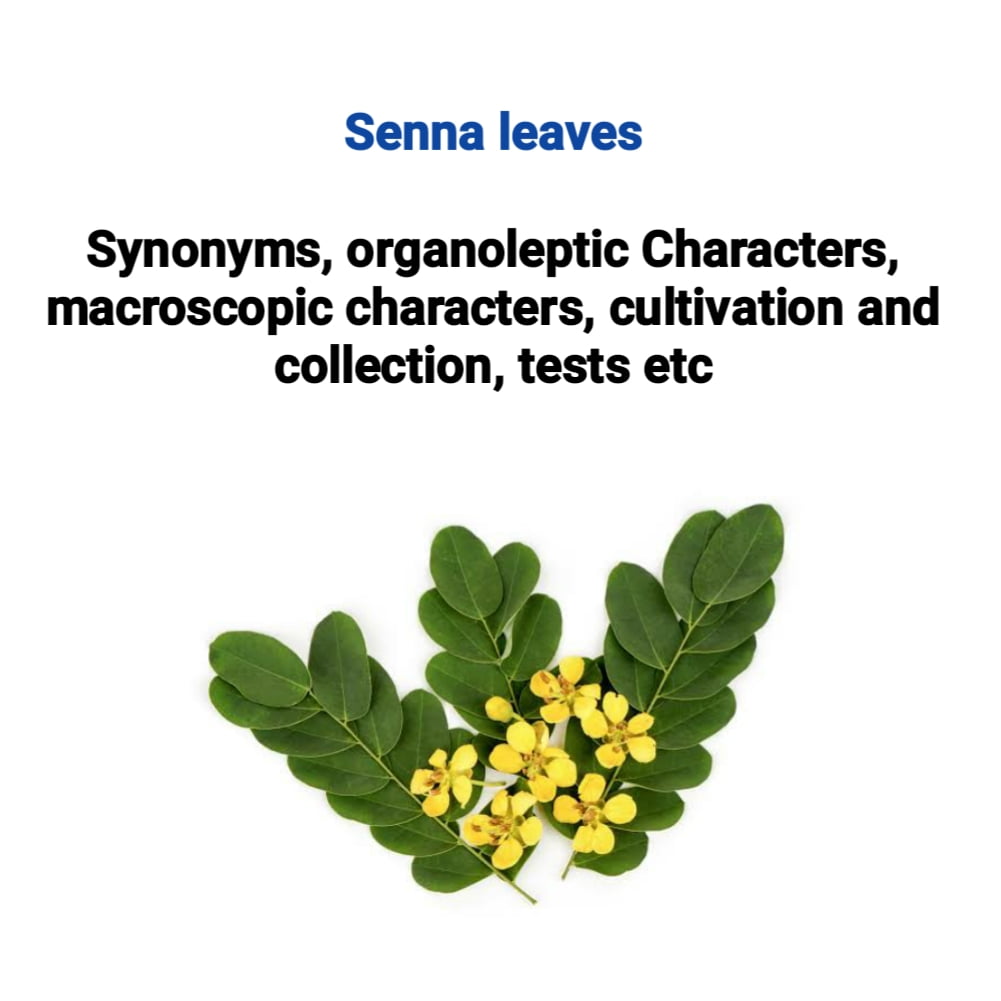Senna leaves – senna leaves pharmacognosy Senna is a dried leaf of a plant. Which contains glycosides. Senna leaves also called as senai ki patti due to its historical events in past. In this article you will see about what is senna, Synonyms, organoleptic Characters, macroscopic characters, cultivation and collection, tests and many more.
Senna leaves

senna leaves pharmacognosy
What is senna leaves
It is a laxative drug. Which loosen stools. Use to treat and prevent from constipation. Which has US FDA approval. Let us study more in detail about senna leaves :
Senna leaves Synonyms
Synonyms : Indian senna, Tinnevelly senna, senai ki patti
Senna leaves in hindi
senai ki patti which is approved by DCGI. An allopathy drug.
Senna leaves botanical name
Biological source: it is obtained from dried leaflets and pods of Cassia angustifolia (Indian senna) and Cassia acutifolia (Alexandrian senna) which belongs to family Leguminosae.
Geographicaly distributed in:
It is cultivated and collected in India. Indian senna cultivation found in Tinnevelly, Madurai and Ramanathapuram districts of Tamil Nadu. It is also cultivates in Cudappa (Andhra Pradesh), kutch (Gujrat) and in Maharashtra.
Senna leaves cultivation in india
Cultivation and collection
• ultivates by sowing the seeds by Broadcasting method or dibbling method.
• It needs about 19 kg of seeds per hectare.
• Before the sowing of seeds land is ploughed twice.
• Cultivation is done two times in a year in March and November mostly.
• Red and black soil as well as use of nitrogenous fertilizers is beneficial.
• Harvesting of leaves is done after 3 to 4 months, for harvesting three steps are followed. which is given below:
1. 1st plucking is done when leaflets are Thick, Full grown and greenish.
2. Just After a one month, 2nd plucking.
3. Then After 4 to 6 weeks, 3rd plucking is done
Then after that nicely collections are collected then in a dry place or room for 5 to 10 days they are spread over there until they dry.
• After that packing is done nicely. This was the cultivation and collection of Indian senna.
Macroscopical characters
• Colour – yellowish green
• Odour – slight
• Taste – Mucilaginous, bitter, characteristic
• Size – 7 to 8 mm in width and 25 to 60 mm in length.
• Shape – leaves are lanceolate, entire acute apex with a spine at top.
• Leaf – Isobilateral (palisades cells are present on both the surface upper epidermis as well as lower epidermis)
Senna leaves diagram

Microscopic characters
Features that can we identify and to distinguish the species of senna leaves. In microscopical structure of senna the palisade cells which present in upper epidermis and lower epidermis that’s why it is called as isobilateral leaf. Palisade cells traps the sunlight and responsible for photo synthesis Calcium oxalate is present which is of roseate type. Trichomes in senna are warty Trichomes. • Microspically two varieties of senna are distinguished by their vein-islet number, stomatal index and palisade ratio.
• Characteristic feature is cluster sheath (for support) and collenchyma, also a spongy parenchyma, xylem and phloem in Vascular bundle are present.
Chemical constituents
Senna is a glycoside containing drug so in this anthraquinone glycoside present. It is called as anthraquinone glycoside because in this anthraquinone moeity is present. It contains sennoside A, sennoside B, sennoside C, sennoside D, Emodin(for stomach pain) ,chrysophanol, Aloe Emodin, Rhein. Two naphthalene glycoside present which is 6-hydroxy musizin glycoside which is present in Alexandrian senna. While Tinnevelly glycoside present in Indian senna. Flavanol and kaempferol also present.
Chemical Test Chemical constituents of leaf tested by performing a test which is known as Borntrager test for anthraquinones. Test is followed as. The leaves are boiled with dilute sulphuric acid. After boiling, filtered. Filtrate is cooled down. Filtrate is mixed with organic solvent, and shake it. Separation of organic solvent and add equal amount of dilute Ammonia which produces pink colored layer and then red indicates presence of anthraquinone.
Use of senna leaves
Uses : The best use of senna is purgative because it increases the peristalsis movement of intestine. Also used in skin diseases, senna powder may treat arthritis.
Adulterants and substitutes
The given below are the adulterants and substitutes that can be found in senna.
1. Dog senna (Cassia obovata) – it can be identify by using the shape of leaves which is obovate in shape, it consists of papillose cells in lower epidermis.
2. Palthe senna (Cassia auriculata) – Distinguish by absence of anthraquinone glycoside
3. Arabian senna – in this senna vein islet number are different so you can easily distinguish between them.
Marketed products
Some of the given below are the senna products.
Constivac,
Softovac Isova powder,
Kultab tablet.
FAQ related to senna leaves
what is senna leaves called in india?
Senna leaves are also called by different names in different regions of India senna patti in hindi, Nilavrai in Tamil, sena sopu in kannada, sonamukta in marathi, sena patte in punjabi.
Is senna leaf safe to take daily?
It can be used for short period as laxative but it is not safe for long term use. Consult to doctor if you have to take daily. It may cause dependency.
what is the English name for senna leaves?
Indian senna and Alexandrian senna are the names of senna leaves in English.










